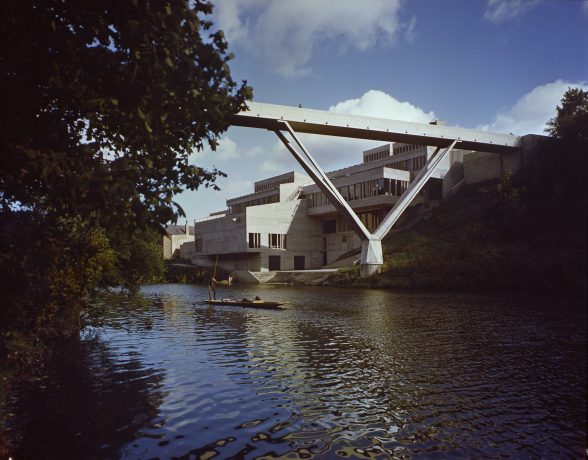This website uses cookies
This website uses cookies to enable it to function properly and to analyse how the website is used. Please click 'Close' to accept and continue using the website.



The Twentieth Century Society is celebrating the success of a hard fought four-year battle to gain listing protection for Dunelm House, Durham’s magnificent Brutalist student union building which stands on the banks of the River Wear.
C20 Society’s head of casework Clare Price said: “I am delighted that the Society’s campaign to persuade the Minister to list Dunelm House has finally been successful. It is such a striking building in a stunning location and fully deserves recognition at a national level. This result makes the hard work and tenacity of all involved worthwhile despite the long wait! We look forward to working with the university to identify ways the building can continue in use as there are so many exciting possibilities for it.”
The five-level concrete building was constructed between 1964 and 1966 to the designs of Richard Raines of the Architects’ Co-Partnership, under supervision of the partner Michael Powers. It responds cleverly and dramatically to a very difficult site in the Wear Gorge, and as a counterpart and compliment to Sir Ove Arup’s adjacent Grade I-listed Kingsgate Bridge and the beautiful cathedral on the other side. Arup acted as structural engineer and architectural advisor and is famously featured in a bust on one of the outside walls.C20’s campaign started in 2016 when Durham University applied for a Certificate of Immunity against listing; it was later announced that they were planning to demolish the building as part of a redevelopment masterplan. C20 argued strongly that the building deserved to be listed and that the COI should be refused. Although Historic England recommended Grade II* listing, the Secretary of State disagreed, refusing to list it even at Grade II.
Our first request for a full reappraisal was unsuccessful, but our second, accompanied by a Freedom of Information request for disclosure of all documentation, was granted. This review has now finally and triumphantly led to the building being listed at Grade II.
The university’s consultants had maintained that Dunelm House was in poor condition, as a result of which it was under-utilised, the original design was inflexible, the concrete of the structure was failing and the roof had never worked properly. These claims were strongly disputed by C20 and HE.
C2O’s Clare Price said at the time: “We are of the opinion that the issues are ones of repair and that they can be addressed. State of repair is not a valid consideration when deciding whether a building can be listed – a necessary precaution to prevent deliberate neglect. Many buildings of this period, listed and unlisted, suffer from problems with concrete, often caused by lack of maintenance or inappropriate repairs. These issues have successfully been resolved in numerous cases.” She pointed out that the original roof has never been replaced which would be expected in a building of this age with “design defects.”
A crowdfunding campaign was launched in 2017 to fund a design charrette to test and develop alternative futures for Dunelm House. This was led by the Save Dunelm House Team and supported by C20 and Newcastle University School of Architecture, Planning and Landscape.
Adrian Green, a historian of architecture based at Durham University, said: “The ‘Caring for Brutalism’ conference held in Dunelm House in October 2017 brought together experts on Brutalism and Post- War university architecture. The conference made plain the outstanding significance of Dunelm House and its special place in the history of Durham University. It was built to embody 1960s values about turning students into cultivated citizens. The building was erected with public funds from the University Grants Committee, responding to the Robbins Report on University Education. The engineer Ove Arup commented – ‘There are two routes to happiness. One is to grab directly, the other is to recognise ourselves in human community.’ For Arup, Dunelm House and Kingsgate Bridge embody the latter. Dunelm House is a unique 20th Century expression of a long architectural tradition in Durham – of a human community gathered around a Cathedral. The building was self-consciously designed to bring about a sense of human community, and provides wonderful views of the Cathedral. Listing the building not only secures its future, but will encourage the appreciation of this international quality building as a cultural asset.”
In addition to winning both a Civic Trust award and the RIBA Bronze Medal for 1966, the building was positively reviewed at the time of its completion and has subsequently been praised many times. Architectural historian Nikolaus Pevsner called the block ’Brutalist by tradition but not brutal to the landscape… the elements, though bold, [are] sensitively composed’.
The Architect’s Journal described it as “uncompromisingly modern yet markedly respectful of the splendour of the site” describing the “joy” of the Kingsgate Bridge as being “matched by the convincing and delightful huddle of Dunelm House. Also in 1966, Concrete Quarterly called it “sophisticated” and Interbuild “a completely satisfying building”. Other commentators have also enthused; the late Douglas Wise, professor of architecture at Newcastle University described it as “the greatest contribution modern architecture has made to the enjoyment of an English medieval city.” Jack Lynn’s article in the Architect’s Journal in 1972 noted the strong Nordic influences and the inclusion of furniture designed by Alvar Aalto as completing the composition.
Key dates
COI application submitted by Durham University 2016
C20 Objection and listing request 28 June 2016
DCMS refusal 6 December 2016
C20 first appeal 10 January 2017
Listing refused by DCMS 26 October 2017
C20 second appeal 22 November 2017 on the grounds that there have been irregularities in the listing decision process, and there is evidence that the decision has been wrongly made
Click here for the website giving details of the Caring for Brutalism conference.

Become a C20 member today and help save our modern design heritage.